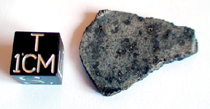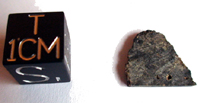NWA 1669 Al Mala'ika
The shergottites are named for their type specimen, an achondrite that
fell in Shergotty, India, in 1865. Comprising 17 distinct members, they
represent the most abundant type of Martian meteorite. Shergottites are
igneous rocks of volcanic or plutonic origin, and they resemble
terrestrial rocks more closely than do any other achondrite group. They
all show exceptionally young crystallization ages of about 150 to 200
million years, and they usually exhibit signs of severe shock-metamorphism.
Typically, the plagioclase in shergottites has been converted to
maskelynite, a glass that is produced when plagioclase is subjected to
shock pressures of at least 30 GPa. It is likely that the maskelynite was
formed by the impact forces that blasted the shergottites from the Martian
surface and into space. Calculations show that it requires a major impact
event to accelerate any material to a speed high enough to escape the
planet's gravity - one of the reasons why the SNC meteorites are such a
rare class. Based upon their mineral compositions, the shergottites are
further subdivided into two distinct subgroups: the basaltic subgroup, and
the lherzolitic subgroup.
|
|
|
|
|
|
|
|
|
|
|
|
|
NWA 1669 01
2.807 gr
Full slice with crust for this shergotitte with a
TKW of only 36 gr
SOLD. |
|
|
|
 
|
|
|
|
|
|
|
  |
|
|
|
NWA 1669 02
0.442 gr
Half Full slice with fusion crust
SOLD
|
|
|
|
|
|
|
AL MALA’IKA (NWA 1669): A
NEW SHERGOTTITE FROM MOROCCO/MINERALOGY
AND PETROLOGY. A.Jambon1 , M. Bohn2, O.
Boudouma1, H. Chennaoui-Aoudjehane1,3, and I.
Franchi4, 1Université P. et M. Curie, Paris 6, (France), 2Université
de Bretagne occidentale Brest, 3Univ Casablanca, 4OpenUniversity, Milton Keynes
(UK).
Introduction: Al
Mala’ika (NWA1669) a meteorite of 36g, found
in 2001 has been recently identified as a shergottite. The single
stone is covered with desert varnish with a few remnants of fusion crust.
It is a fine grained rock, with two closely
intricated pyroxenes: pigeonite En 58-25 Wo
9-19 Fs 32-61 and augite En 47-19 Wo 39-24 Fs 54-18. Their
FeO/MnO ratio of 34 on the average, is typical for a shergottite.
Their Mg indicate that augite crystallized first. Plagioclase
transformed to maskelynite (Ab41-53 Or1-6 An58-42) is injected
between pyroxene phenocrysts. Accessory minerals are: merrilite,
Cl-apatite, pyrrhotite, ulvöspinel, ilmenite, silica and baddeleyite.
Impact melt pockets contain submicrometric stishovite
needles. The rock is highly fractured at all
scales : the cores of pyroxenes are crosscut
by wide fractures while their margins are cut only by numerous
small fractures. Maskelynite is marginally affected by few
of the largest ones. Secondary carbonate is
present in some fractures. The major and trace
element composition is under study. Oxygen
Isotopes: .17O=
0.30‰, ä17O=
2.85‰, ä18O=
4.91‰. These values are in agreement with
the martian origin of this meteorite. According
to the experimental works, the compositions of pyroxenes
indicate that augite crystallized first followed by the syncrystallisation
of augite and pigeonite. According to the experimental
work, this order of crystallization indicates a significant
P(H2O), on the order of 0.2 Gpa, pointing out the significant
abundance of water of the magma compared to the terrestrial
basaltic equivalents.
66th
Annual Meteoritical Society Meeting (2003)
|